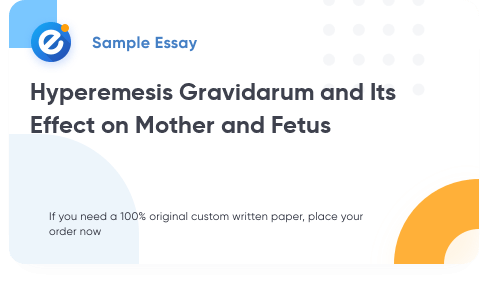
Vomiting of pregnant women is a pathological condition in the first half of pregnancy that is attributable to the early toxicosis. The last one is a status of pregnant women that arises from the development of the whole of the ovum or some of its elements. This paper examines the reasons and effects of toxicosis (also known as hyperemesis gravidarum) on maternal and fetal organisms.
Vomiting during pregnancy is much more dangerous than just any usual morning sickness. In some cases, women need to be hospitalized when multiple symptoms (including central nervous system dysfunction, cardiovascular and metabolic disorders) characterize the state of their health. Hyperemesis gravidarum is a complex clinical syndrome that is characterized by digestive disorders, leading to significant violations: dehydration, changes in metabolic and electrolyte balance. This complication of pregnancy has an impact on its further course and fetal development (Kuscu & Koyuncu, 2002, p. 76). According to Fejzo et al. (2009), Hyperemesis gravidarum can become a reason for embryonic growth restriction, serious maternal and fetal morbidity or even death (p.1981). Hyperemesis gravidarum complications include electrolyte imbalance, depression, anxiety, inadequate nutrition of an embryo, and excessive load on vital organs including liver, heart, kidneys, and brain.
Calculate the cost of essay
Disturbances of the relationship between the cortex and subcortical structures, metabolic and immunological changesaccompany early toxemia during pregnancy. The terms of vomiting coincide with the start of circulation and accumulation of polysaccharides in the chorion. Therefore, its termination is related to the beginning of the high activity in the placenta. The greatest manifestation of vomiting is observed during the period of the increased proliferation of the lymphoid tissue and the yield of lymphocytes in the peripheral blood. Apparently, toxemia reflects a partial failure of mechanisms that prevent women’s immune system from attacking their own tissue or organ-specific self-antigens associated with the placenta.
Hemodynamic, metabolic, and neuroendocrine disorders accompany vomiting. It leads to disrupted water-salt metabolism, decreased tone, antitoxic, glycogen and protein function of the liver. Hyperemesis gravidarum changes excretion of estrogen and glucocorticoids. It causes increased oxygenation of arterial blood. There is a shift of acid-base balance toward acidosis (Kuscu & Koyuncu, 2002, p.77). An occurring accumulation of oxidized products of fat leads to breakdown. Hyperemesis gravidarum causes changes in the rheological properties of blood manifested in hematocrit level increase, high blood viscosity (mainly due to the rise in fibrinogen concentration), growing the capacity of erythrocytes aggregation. With increasing of depletion and intoxication, changes in the liver, kidneys, brain and other organs occur (Fejzo et al., 2009, p.1983). These changes can even lead to a coma when the termination of pregnancy may be too late. It relates to the fact that the state of the individual peculiarities of the metabolic processes does not reflect the complex system of homeostasis, functional and morphological structures of the vital organs.
Limited Time
special offer
Gestational toxicosis is an immune conflict between mother and fetus. Therefore, the fetus always comes with serious lesions. Vomiting experienced by pregnant woman reduces birth weight and leads to premature birth (Fejzo et al. 2009, p. 1985). Besides, it increases the risk of emotional and behavioral disorders in adulthood.
During severe toxicity, oxidized metabolites, which can penetrate to the fetus, accumulate in the mother’s blood. In severe forms of the disease, there is clearly expressed deviation in the ratio of protein fractions. There is an infringement of electrolyte metabolism. Particularly, sodium retention is shown in the body. Consequently, there is a significant fluid retention. Vomiting causes a decrease in the absorption of oxygen by tissues primarily due to disturbances in the cardiovascular system.
Essential changes, which represent a particular danger to the fetus, occur in the placenta. As a result of malfunctions in the mother’s body and the changes in the placenta, there are hypoxic conditions for the existence of the fetus. An insufficient intake of nutrients, especially amino acids, is marked. The development of subcutaneous fat and tissue turgor of premature infants born from mothers with toxemia is inadequate or absent: dry, flabby skin. There is a decrease in muscle tone. The sucking activity of many children is reduced. There may be vomiting. Newborns badly keep warm and are easy to cool. This fact can be explained by the insufficient development of the subcutaneous fat layer and reduction of stocks of fat that has great importance for heat generation in the neonatal period. Sometimes, these children are sluggish. However, more often, irritability and anxiety characterized them. Physiological reflexes, which are typical of newborns, are often reduced.
Benefit from Our Service: Save 25%
Along with the first order offer - 15% discount, you save extra 10%
since we provide 300 words/page instead of 275 words/page
Comprehensive treatment for uncontrollable vomiting of pregnant women includes compliance with the protective regime, normalization of water-electrolyte balance, the use of antiemetics (anti-emetics such as Motilium, etc.) of the medium action, and injecting drugs. In very rare cases, during the development of critical conditions as a result of uncontrollable vomiting, as well as the ineffectiveness of preventive actions, there is a need to terminate the pregnancy in the interests of a woman’s life.
Nausea and vomiting during pregnancy are not uncommon. Most often, it occurs in the very early stages and is one of toxicity signs. Nonetheless, pregnant women often vomit in the last trimester, when preeclampsia is developed. In most cases, vomiting in pregnancy is a temporary symptom. At the same time, there can be less optimistic forecasts. Heavy pathology, known as hyperemesis gravidarum, is uncontrollable vomiting affecting pregnant women. Symptoms of the disease include multiple copious vomiting leading to dehydration, weight loss, and electrolyte imbalance. It is important to realize the danger of hyperemesis gravidarum as it can become the cause of fetal and maternal death.

